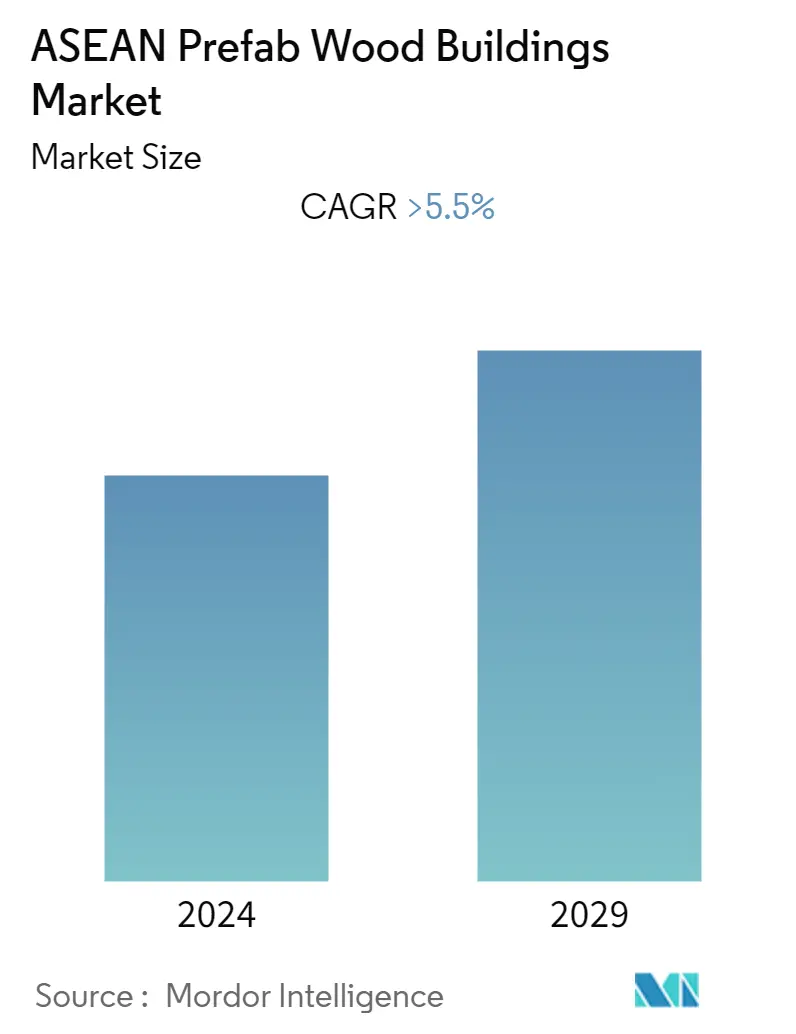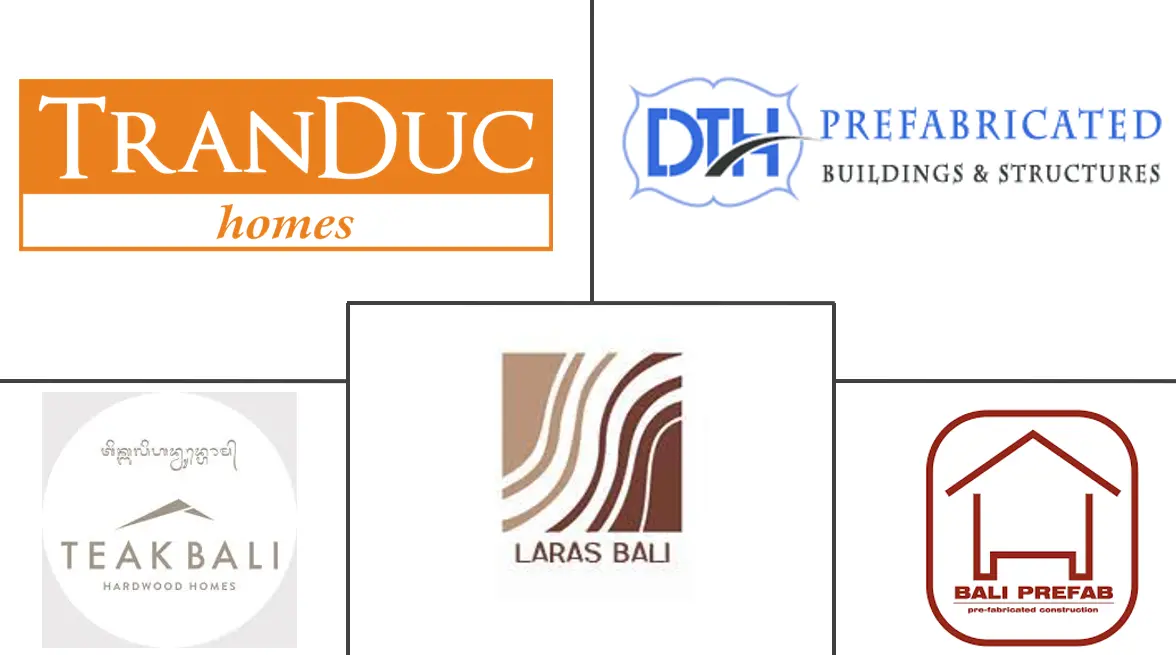Market Size of ASEAN Prefab Wood Buildings Industry

| Study Period | 2020 - 2029 |
| Base Year For Estimation | 2023 |
| Forecast Data Period | 2024 - 2029 |
| Historical Data Period | 2020 - 2022 |
| CAGR | > 5.50 % |
Major Players
*Disclaimer: Major Players sorted in no particular order |
ASEAN Prefab Wood Buildings Market Analysis
The ASEAN Prefab Wood Buildings Market is expected to grow at a CAGR of more than 5.5% during the forecast period. During the COVID-19 outbreak, the workers fled to their home countries. Due to labor shortage, timely completion of the projects also became a major challenge for developers. Moreover, due to the supply chain disruption, developers faced the problem of obtaining cheap input materials as the production units were closed.
Countries such as Indonesia, Philippines and Thailand are expected to experience significant urbanization growth. Most countries in Southeast Asia are facing growing environmental problems-the natural consequence of economic development. Sustainable construction has been growing in Southeast Asia, including Malaysia. Recently, many new developers and contractors have switched from traditional buildings to prefabricated buildings to adapt to this new trend in the Thai residential market. As sustainable building initiatives continue to be a main discussion topic around the world, green sustainable building standards are progressively becoming the norm, and for here in Vietnam, it is expected that these green buildings to quickly become the most sought-after buildings and spaces in the market to occupiers.
Prefabricated wooden buildings have an opportunity to grow as the cost of traditional construction has increased in the region as a result of a labor shortage and rising fuel and construction material prices. In Thailand housing prices are projected to rise by 5-10% this year 2023 as the standard home construction price index continued an upward trend, with a year-on-year increase of 5.6% in the fourth quarter of 2022 amid a labour shortage. In Malaysia all building materials recorded increases in May 2022 as compared to a year ago. The unit price index of building materials increased between 4.1 per cent to 19.9 per cent. The price index per unit of steel and steel & sections increased by 19.9 per cent and 18.1 per cent respectively in May 2022 as compared to May 2021. In addition, the price index per unit of cement also increased by 12.4 per cent during the period. In March 2022, Vietnam Association of Building Materials stated that due to the sharp increase in input costs, especially petroleum, businesses are forced to increase prices.
ASEAN Prefab Wood Buildings Industry Segmentation
Prefabricated wood construction kits, similar to life-sized Legos, are constructed out of prefabricated components that are supplied and installed on-site. This is most commonly accomplished by the use of prefabricated panels that may create complete portions of a building, such as roofing components or structure (ceiling, decking, and beams), building structure (wall panels, beams, columns, and shear paneling), and even glazing packages. A complete assessment of the ASEAN Prefab Wood Buildings Market includes an assessment of the economy market overview, market size estimation for key segments, and emerging trends in the market segments in the report. The report sheds a light on the market trends like growth factors, restraints, and opportunities in this sector. The competitive landscape of the ASEAN Prefab Wood Buildings Market is depicted through the profiles of active key players. The report also covers the impact of COVID - 19 on the market and the future projections.
The ASEAN Prefab Wood Buildings Market is segmented By Panel Systems (Cross-laminated timber (CLT) panels, Nail-laminated timber (NLT) panels, Dowel-laminated timber (DLT) panels, Glue-laminated timber (GLT) columns and beams), By Application (Single Family Residential, Multi-family Residential, Office, Hospitality, Others), By Country (Indonesia, Thailand, Malaysia, Singapore, Vietnam, Philippines, Rest of ASEAN). The report offers market size and forecast values (USD billion) for all the above segments.
| By Panel Systems | |
| Cross-laminated timber (CLT) panels | |
| Nail-laminated timber (NLT) panels | |
| Dowel-laminated timber (DLT) panels | |
| Glue-laminated timber (GLT) columns and beams |
| By Application | |
| Single Family Residential | |
| Multi-family Residential | |
| Office | |
| Hospitality | |
| Others |
| By Country | |
| Indonesia | |
| Thailand | |
| Malaysia | |
| Singapore | |
| Vietnam | |
| Philippines | |
| Rest of ASEAN |
ASEAN Prefab Wood Buildings Market Size Summary
The ASEAN Prefab Wood Buildings Market is poised for significant growth, driven by urbanization and the increasing demand for sustainable construction solutions. As countries like Indonesia, the Philippines, and Thailand experience rapid urbanization, the shift towards prefabricated wooden buildings is becoming more pronounced. This transition is largely due to the rising costs of traditional construction methods, exacerbated by labor shortages and increased prices of materials such as steel and cement. The market is further bolstered by government incentives and the need for environmentally friendly building practices, as seen in countries like Vietnam, which is actively pursuing green building standards to reduce carbon emissions. The use of wood in construction is gaining traction, supported by advancements in automation and robotic collaboration, which enhance productivity and competitiveness.
The market landscape is characterized by a fragmented yet growing industry, with key players such as Tran Duc Homes, DTH Prefab, and PT Teak Bali leading the charge. The construction of prefab houses offers a faster and more cost-effective alternative to traditional methods, aligning with the region's increasing housing demand and urban population growth. Governments in the region are setting ambitious targets for housing units and emissions reduction, further propelling the adoption of prefab wood buildings. Notable projects, such as the Nanyang Technological University Academic Building in Singapore, highlight the region's commitment to integrating mass-engineered timber solutions. As the market evolves, the focus on reducing energy consumption and greenhouse gas emissions remains a critical driver, positioning prefab wood buildings as a viable solution for sustainable urban development in Southeast Asia.
ASEAN Prefab Wood Buildings Market Size - Table of Contents
-
1. Market Insights and Dynamics
-
1.1 Market Overview
-
1.2 Market Dynamics
-
1.2.1 Drivers
-
1.2.2 Restraints
-
1.2.3 Opportunities
-
-
1.3 Industry Attractiveness Porters Five Forces
-
1.3.1 Threat of New Entrants
-
1.3.2 Bargaining Power of Buyers/Consumers
-
1.3.3 Bargaining Power of Suppliers
-
1.3.4 Threat of Substitute Products
-
1.3.5 Intensity of Competitive Rivalry
-
-
1.4 Value Chain/Supply Chain Analysis
-
1.5 Technological Advancements
-
1.6 Government Regulations and Initiatives
-
1.7 Brief on Different Structures Used in the Prefabricated Buildings Industry
-
1.8 Cost Structure Analysis of the Prefabricated Buildings Industry
-
1.9 Impact of COVID-19 on the market (Short-term and Long-term Impact on the Market and on the Economy)
-
-
2. Market Segmentation
-
2.1 By Panel Systems
-
2.1.1 Cross-laminated timber (CLT) panels
-
2.1.2 Nail-laminated timber (NLT) panels
-
2.1.3 Dowel-laminated timber (DLT) panels
-
2.1.4 Glue-laminated timber (GLT) columns and beams
-
-
2.2 By Application
-
2.2.1 Single Family Residential
-
2.2.2 Multi-family Residential
-
2.2.3 Office
-
2.2.4 Hospitality
-
2.2.5 Others
-
-
2.3 By Country
-
2.3.1 Indonesia
-
2.3.2 Thailand
-
2.3.3 Malaysia
-
2.3.4 Singapore
-
2.3.5 Vietnam
-
2.3.6 Philippines
-
2.3.7 Rest of ASEAN
-
-
ASEAN Prefab Wood Buildings Market Size FAQs
What is the current ASEAN Prefab Wood Buildings Market size?
The ASEAN Prefab Wood Buildings Market is projected to register a CAGR of greater than 5.5% during the forecast period (2024-2029)
Who are the key players in ASEAN Prefab Wood Buildings Market?
Tran Duc Homes, DTH Prefab, PT Teak Bali , Laras Bali Prefab and Bali Prefab House are the major companies operating in the ASEAN Prefab Wood Buildings Market.

